Abstract
Changes in subunit interaction energies linked to the allosteric transition of the regulatory enzyme aspartate transcarbamoylase (ATCase; EC 2.1.3.2) from Escherichia coli are localized in part at interfaces between the six catalytic (c) and six regulatory (r) polypeptide chains. Site-directed mutagenesis has been used to construct enzymes with amino acid substitutions in a limited region of the zinc-binding domain of the r chains. Substitution of Ser or His for r114 Cys, one of four cysteines binding the structural zinc ion in the regulatory chain, leads to incorrectly folded chains as shown by the inability to detect stable assembled holoenzyme in cell extracts. Replacement of r111 Asn by Ala at the interface between an r chain and a c chain in the apposing catalytic trimer causes a complete loss of the homotropic and heterotropic effects characteristic of wild-type ATCase. Moreover, sedimentation velocity experiments demonstrated that this mutant enzyme exists in the R ("relaxed") conformation in the absence of active site ligands due to preferential destabilization of the T ("taut") conformation relative to the R state. In contrast, replacement of r113 Asn by Ala at the interface between adjacent r and c chains leads to an increase in the cooperativity of the enzyme. When r139 Lys is replaced by Met, Vmax is reduced by 50% compared to wild-type ATCase, whereas it is increased about 2-fold when r142 Glu is replaced by Asp. Amino acid substitutions in this domain significantly affect subunit interaction energy as measured by rate of subunit exchange when holoenzymes are incubated with isolated catalytic subunits, thus permitting measurements of the effect of the bisubstrate analog N-(phosphonacetyl)-L-asparatate in weakening intersubunit interactions. Subunit exchange increased about 9-fold for the r142 Glu----Asp mutant and almost 20-fold for the r142 Glu----Ala mutant in the presence of the ligand.
Full text
PDF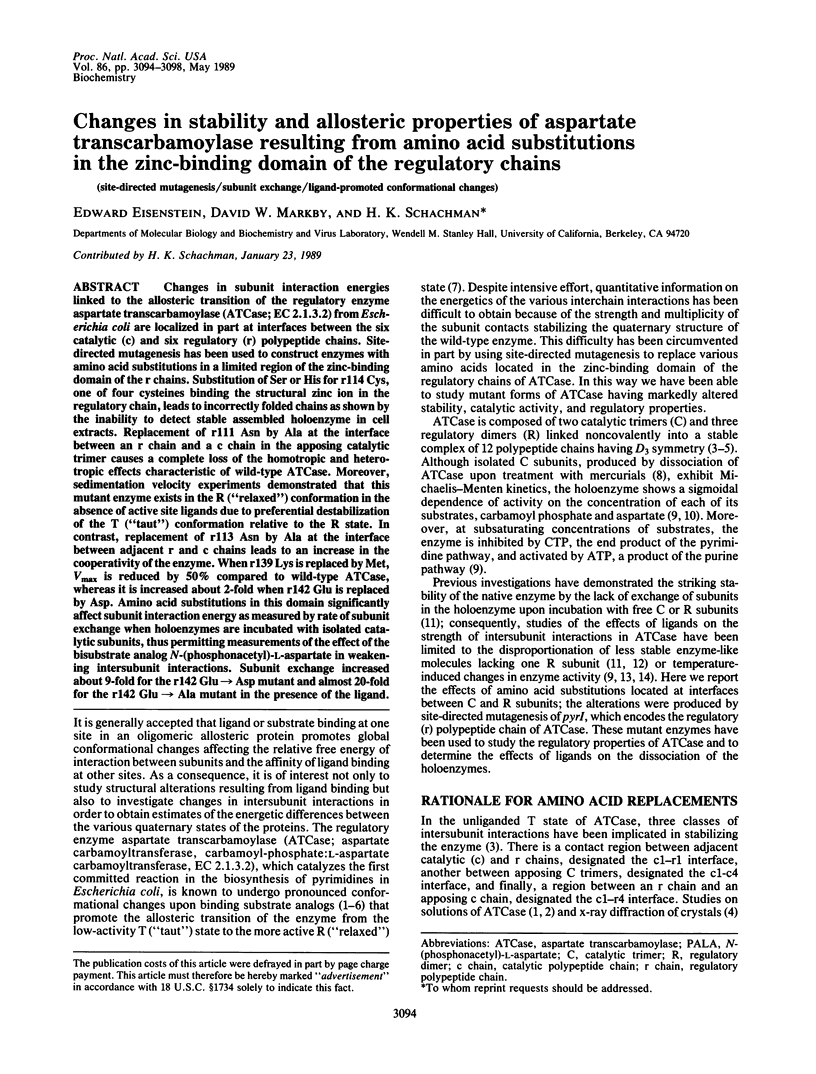
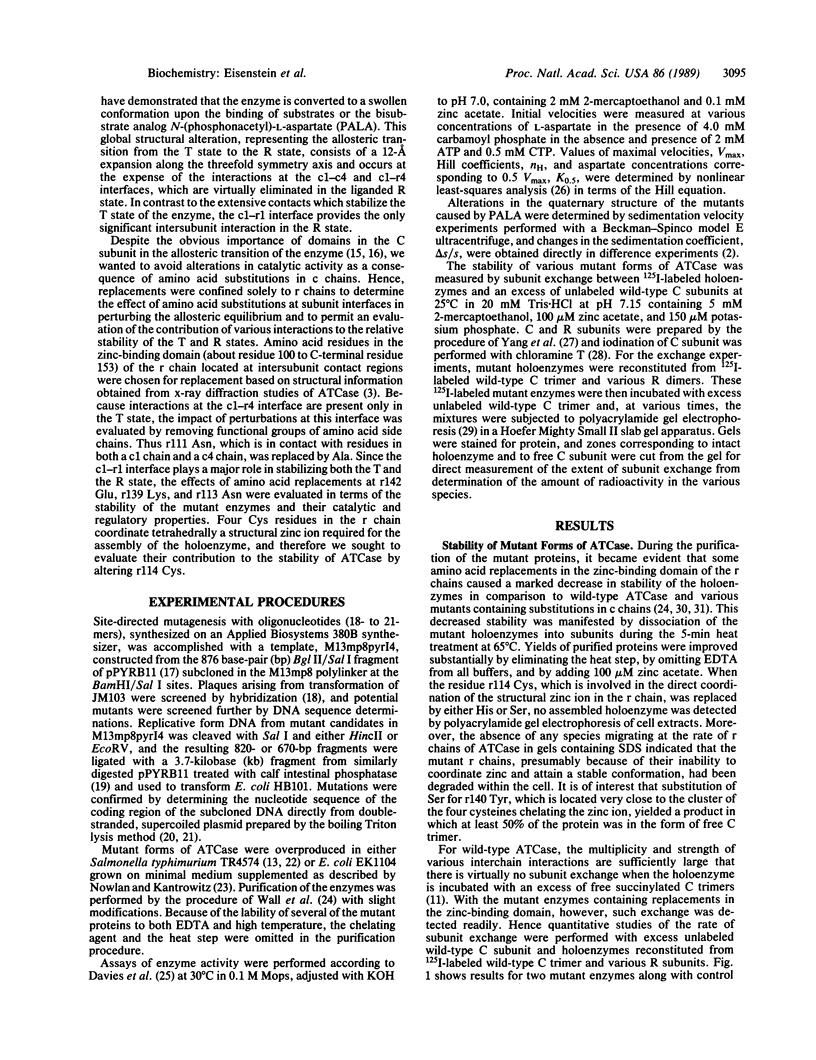
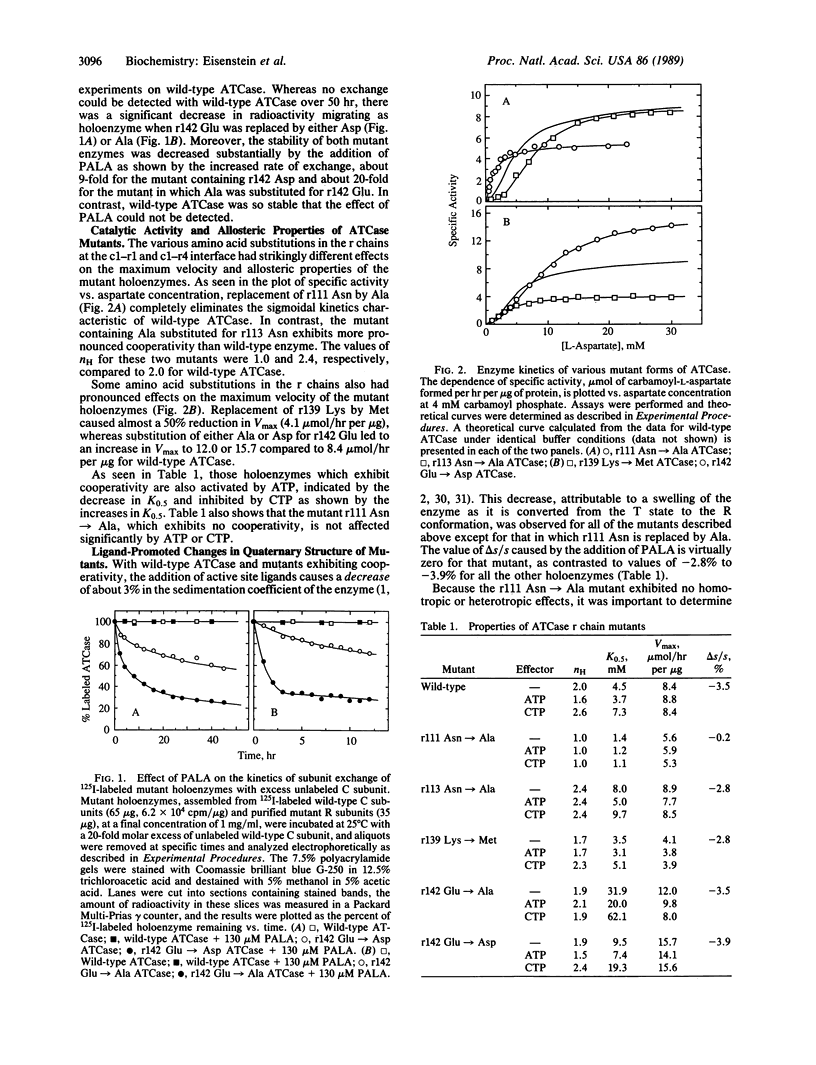
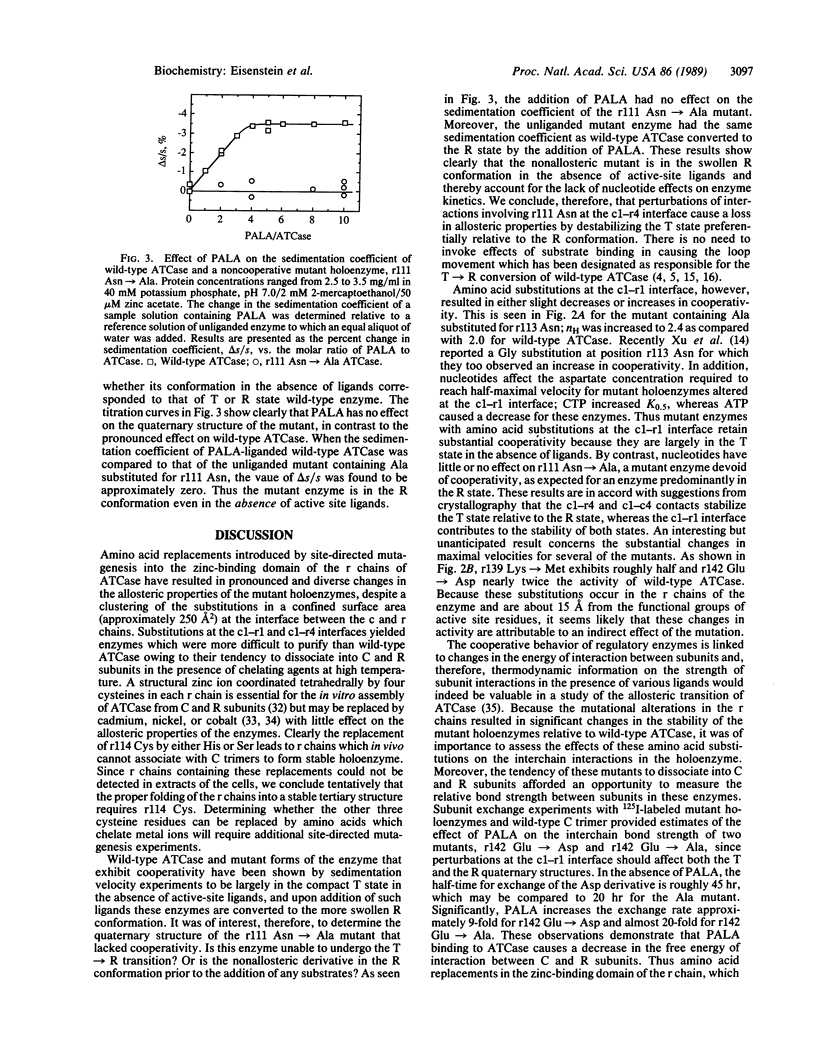
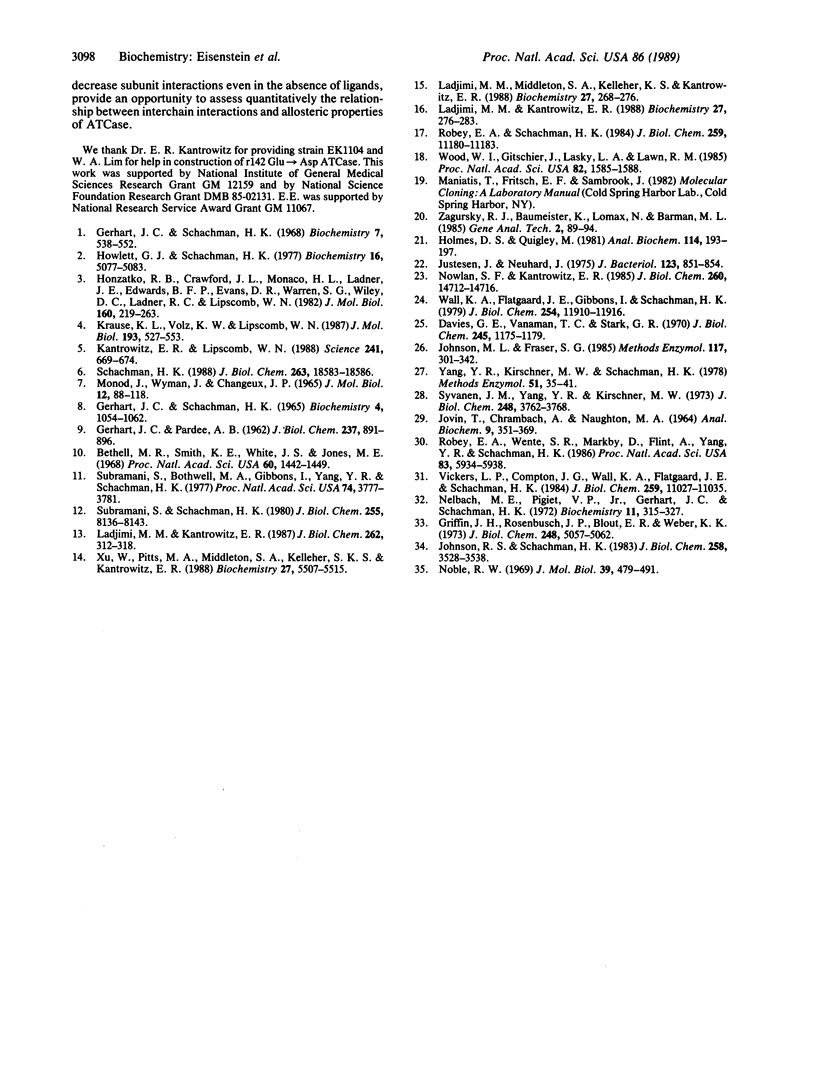
Selected References
These references are in PubMed. This may not be the complete list of references from this article.
- Bethell M. R., Smith K. E., White J. S., Jones M. E. Carbamyl phosphate: an allosteric substrate for aspartate transcarbamylase of Escherichia coli. Proc Natl Acad Sci U S A. 1968 Aug;60(4):1442–1449. doi: 10.1073/pnas.60.4.1442. [DOI] [PMC free article] [PubMed] [Google Scholar]
- Davies G. E., Vanaman T. C., Stark G. R. Aspartate transcarbamylase. Stereospecific restrictions on the binding site for L-aspartate. J Biol Chem. 1970 Mar 10;245(5):1175–1179. [PubMed] [Google Scholar]
- GERHART J. C., PARDEE A. B. The enzymology of control by feedback inhibition. J Biol Chem. 1962 Mar;237:891–896. [PubMed] [Google Scholar]
- Gerhart J. C., Schachman H. K. Allosteric interactions in aspartate transcarbamylase. II. Evidence for different conformational states of the protein in the presence and absence of specific ligands. Biochemistry. 1968 Feb;7(2):538–552. doi: 10.1021/bi00842a600. [DOI] [PubMed] [Google Scholar]
- Gerhart J. C., Schachman H. K. Distinct subunits for the regulation and catalytic activity of aspartate transcarbamylase. Biochemistry. 1965 Jun;4(6):1054–1062. doi: 10.1021/bi00882a012. [DOI] [PubMed] [Google Scholar]
- Griffin J. H., Rosenbusch J. P., Blout E. R., Weber K. K. Conformational changes in aspartate transcarbamylase. II. Circular dichroism evidence for the involvement of metal ions in allosteric interactions. J Biol Chem. 1973 Jul 25;248(14):5057–5062. [PubMed] [Google Scholar]
- Holmes D. S., Quigley M. A rapid boiling method for the preparation of bacterial plasmids. Anal Biochem. 1981 Jun;114(1):193–197. doi: 10.1016/0003-2697(81)90473-5. [DOI] [PubMed] [Google Scholar]
- Honzatko R. B., Crawford J. L., Monaco H. L., Ladner J. E., Ewards B. F., Evans D. R., Warren S. G., Wiley D. C., Ladner R. C., Lipscomb W. N. Crystal and molecular structures of native and CTP-liganded aspartate carbamoyltransferase from Escherichia coli. J Mol Biol. 1982 Sep 15;160(2):219–263. doi: 10.1016/0022-2836(82)90175-9. [DOI] [PubMed] [Google Scholar]
- Howlett G. J., Schachman H. K. Allosteric regulation of aspartate transcarbamoylase. Changes in the sedimentation coefficient promoted by the bisubstrate analogue N-(phosphonacetyl)-L-aspartate. Biochemistry. 1977 Nov 15;16(23):5077–5083. doi: 10.1021/bi00642a021. [DOI] [PubMed] [Google Scholar]
- JOVIN T., CHRAMBACH A., NAUGHTON M. A. AN APPARATUS FOR PREPARATIVE TEMPERATURE-REGULATED POLYACRYLAMIDE GEL ELECTROPHORESIS. Anal Biochem. 1964 Nov;9:351–369. doi: 10.1016/0003-2697(64)90192-7. [DOI] [PubMed] [Google Scholar]
- Johnson R. S., Schachman H. K. Communication between catalytic and regulatory subunits in Ni(II)- and Co(II)-aspartate transcarbamoylase. Ligand-promoted structural alterations at the intersubunit bonding domains. J Biol Chem. 1983 Mar 25;258(6):3528–3538. [PubMed] [Google Scholar]
- Justesen J., Neuhard J. pyrR identical to pyrH in Salmonella typhimurium: control of expression of the pyr genes. J Bacteriol. 1975 Sep;123(3):851–854. doi: 10.1128/jb.123.3.851-854.1975. [DOI] [PMC free article] [PubMed] [Google Scholar]
- Kantrowitz E. R., Lipscomb W. N. Escherichia coli aspartate transcarbamylase: the relation between structure and function. Science. 1988 Aug 5;241(4866):669–674. doi: 10.1126/science.3041592. [DOI] [PubMed] [Google Scholar]
- Krause K. L., Volz K. W., Lipscomb W. N. 2.5 A structure of aspartate carbamoyltransferase complexed with the bisubstrate analog N-(phosphonacetyl)-L-aspartate. J Mol Biol. 1987 Feb 5;193(3):527–553. doi: 10.1016/0022-2836(87)90265-8. [DOI] [PubMed] [Google Scholar]
- Ladjimi M. M., Kantrowitz E. R. A possible model for the concerted allosteric transition in Escherichia coli aspartate transcarbamylase as deduced from site-directed mutagenesis studies. Biochemistry. 1988 Jan 12;27(1):276–283. doi: 10.1021/bi00401a042. [DOI] [PubMed] [Google Scholar]
- Ladjimi M. M., Kantrowitz E. R. Catalytic-regulatory subunit interactions and allosteric effects in aspartate transcarbamylase. J Biol Chem. 1987 Jan 5;262(1):312–318. [PubMed] [Google Scholar]
- Ladjimi M. M., Middleton S. A., Kelleher K. S., Kantrowitz E. R. Relationship between domain closure and binding, catalysis, and regulation in Escherichia coli aspartate transcarbamylase. Biochemistry. 1988 Jan 12;27(1):268–276. doi: 10.1021/bi00401a041. [DOI] [PubMed] [Google Scholar]
- MONOD J., WYMAN J., CHANGEUX J. P. ON THE NATURE OF ALLOSTERIC TRANSITIONS: A PLAUSIBLE MODEL. J Mol Biol. 1965 May;12:88–118. doi: 10.1016/s0022-2836(65)80285-6. [DOI] [PubMed] [Google Scholar]
- Nelbach M. E., Pigiet V. P., Jr, Gerhart J. C., Schachman H. K. A role for zinc in the quaternary structure of aspartate transcarbamylase from Escherichia coli. Biochemistry. 1972 Feb 1;11(3):315–327. doi: 10.1021/bi00753a002. [DOI] [PubMed] [Google Scholar]
- Noble R. W. Relation between allosteric effects and changes in the energy of bonding between molecular subunits. J Mol Biol. 1969 Feb 14;39(3):479–491. doi: 10.1016/0022-2836(69)90139-9. [DOI] [PubMed] [Google Scholar]
- Nowlan S. F., Kantrowitz E. R. Superproduction and rapid purification of Escherichia coli aspartate transcarbamylase and its catalytic subunit under extreme derepression of the pyrimidine pathway. J Biol Chem. 1985 Nov 25;260(27):14712–14716. [PubMed] [Google Scholar]
- Robey E. A., Schachman H. K. Site-specific mutagenesis of aspartate transcarbamoylase. Replacement of tyrosine 165 in the catalytic chain by serine reduces enzymatic activity. J Biol Chem. 1984 Sep 25;259(18):11180–11183. [PubMed] [Google Scholar]
- Robey E. A., Wente S. R., Markby D. W., Flint A., Yang Y. R., Schachman H. K. Effect of amino acid substitutions on the catalytic and regulatory properties of aspartate transcarbamoylase. Proc Natl Acad Sci U S A. 1986 Aug;83(16):5934–5938. doi: 10.1073/pnas.83.16.5934. [DOI] [PMC free article] [PubMed] [Google Scholar]
- Schachman H. K. Can a simple model account for the allosteric transition of aspartate transcarbamoylase? J Biol Chem. 1988 Dec 15;263(35):18583–18586. [PubMed] [Google Scholar]
- Subramani S., Bothwell M. A., Gibbons I., Yang Y. R., Schachman H. K. Ligand-promoted weakening of intersubunit bonding domains in aspartate transcarbamolylase. Proc Natl Acad Sci U S A. 1977 Sep;74(9):3777–3781. doi: 10.1073/pnas.74.9.3777. [DOI] [PMC free article] [PubMed] [Google Scholar]
- Subramani S., Schachman H. K. Mechanism of disproportionation of asparate transcarbamoylase molecules lacking one regulatory subunit. J Biol Chem. 1980 Sep 10;255(17):8136–8143. [PubMed] [Google Scholar]
- Syvanen J. M., Yang Y. R., Kirschiner M. W. Preparation of 125 I-Catalytic subunit of asparatate transcarbamylase and its use in studies of the regulatory subunit. J Biol Chem. 1973 Jun 10;248(11):3762–3768. [PubMed] [Google Scholar]
- Vickers L. P., Compton J. G., Wall K. A., Flatgaard J. E., Schachman H. K. Comparison of active mutants and wild-type aspartate transcarbamoylase of Escherichia coli. J Biol Chem. 1984 Sep 10;259(17):11027–11035. [PubMed] [Google Scholar]
- Wall K. A., Flatgaard J. E., Schachman H. K., Gibbons I. Purification and characterization of a mutant aspartate transcarbamoylase lacking enzyme activity. J Biol Chem. 1979 Dec 10;254(23):11910–11916. [PubMed] [Google Scholar]
- Wood W. I., Gitschier J., Lasky L. A., Lawn R. M. Base composition-independent hybridization in tetramethylammonium chloride: a method for oligonucleotide screening of highly complex gene libraries. Proc Natl Acad Sci U S A. 1985 Mar;82(6):1585–1588. doi: 10.1073/pnas.82.6.1585. [DOI] [PMC free article] [PubMed] [Google Scholar]
- Xu W., Pitts M. A., Middleton S. A., Kelleher K. S., Kantrowitz E. R. Propagation of allosteric changes through the catalytic-regulatory interface of Escherichia coli aspartate transcarbamylase. Biochemistry. 1988 Jul 26;27(15):5507–5515. doi: 10.1021/bi00415a018. [DOI] [PubMed] [Google Scholar]
- Yang Y. R., Kirschner M. W., Schachman H. K. Aspartate transcarbamoylase (Escherichia coli): preparation of subunits. Methods Enzymol. 1978;51:35–41. doi: 10.1016/s0076-6879(78)51007-0. [DOI] [PubMed] [Google Scholar]


